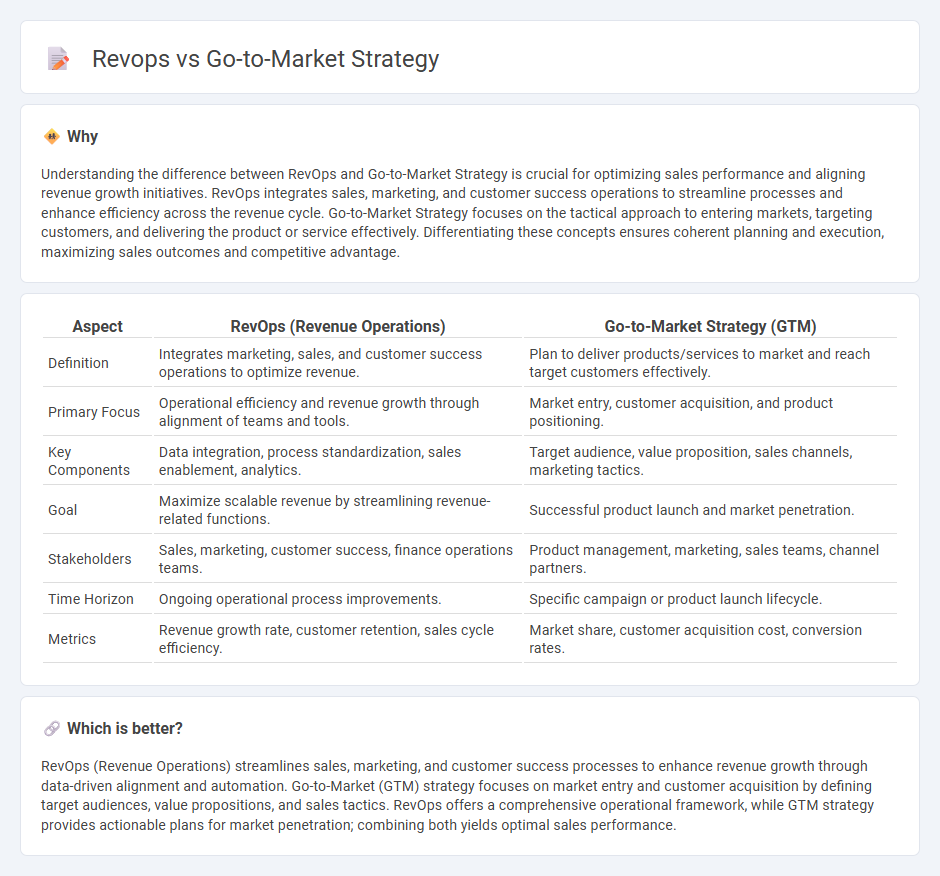
Revenue Operations (RevOps) integrates sales, marketing, and customer success to streamline processes and enhance data-driven decision-making, ensuring consistent growth and operational efficiency. Go-to-Market Strategy focuses on targeted market entry and positioning through tailored value propositions, competitive analysis, and precise customer segmentation. Explore how aligning RevOps with your Go-to-Market Strategy can accelerate revenue generation and market impact.
Why it is important
Understanding the difference between RevOps and Go-to-Market Strategy is crucial for optimizing sales performance and aligning revenue growth initiatives. RevOps integrates sales, marketing, and customer success operations to streamline processes and enhance efficiency across the revenue cycle. Go-to-Market Strategy focuses on the tactical approach to entering markets, targeting customers, and delivering the product or service effectively. Differentiating these concepts ensures coherent planning and execution, maximizing sales outcomes and competitive advantage.
Comparison Table
| Aspect | RevOps (Revenue Operations) | Go-to-Market Strategy (GTM) |
|---|---|---|
| Definition | Integrates marketing, sales, and customer success operations to optimize revenue. | Plan to deliver products/services to market and reach target customers effectively. |
| Primary Focus | Operational efficiency and revenue growth through alignment of teams and tools. | Market entry, customer acquisition, and product positioning. |
| Key Components | Data integration, process standardization, sales enablement, analytics. | Target audience, value proposition, sales channels, marketing tactics. |
| Goal | Maximize scalable revenue by streamlining revenue-related functions. | Successful product launch and market penetration. |
| Stakeholders | Sales, marketing, customer success, finance operations teams. | Product management, marketing, sales teams, channel partners. |
| Time Horizon | Ongoing operational process improvements. | Specific campaign or product launch lifecycle. |
| Metrics | Revenue growth rate, customer retention, sales cycle efficiency. | Market share, customer acquisition cost, conversion rates. |
Which is better?
RevOps (Revenue Operations) streamlines sales, marketing, and customer success processes to enhance revenue growth through data-driven alignment and automation. Go-to-Market (GTM) strategy focuses on market entry and customer acquisition by defining target audiences, value propositions, and sales tactics. RevOps offers a comprehensive operational framework, while GTM strategy provides actionable plans for market penetration; combining both yields optimal sales performance.
Connection
RevOps integrates sales, marketing, and customer success operations to streamline the Go-to-Market (GTM) strategy by aligning teams around unified goals and data-driven processes. This alignment enhances forecasting accuracy, optimizes resource allocation, and accelerates revenue growth. Leveraging RevOps enables companies to execute GTM strategies with greater efficiency and measurable impact on sales performance.
Key Terms
**Go-to-Market Strategy:**
Go-to-Market Strategy defines the blueprint for delivering a product to the target market by aligning product positioning, marketing, sales, and distribution channels to meet specific customer needs effectively. It emphasizes market segmentation, competitive analysis, and tailored messaging to maximize market penetration and revenue growth. Explore our detailed guide to mastering Go-to-Market Strategy for business success.
Target Market
A Go-to-Market strategy specifies the target market segments to maximize product adoption and revenue growth, detailing buyer personas, value propositions, and sales channels. Revenue Operations (RevOps) supports this focus by aligning marketing, sales, and customer success teams to optimize customer lifecycle management and streamline revenue processes within the selected target market. Explore how combining Go-to-Market strategies with RevOps enhances precision and efficiency in reaching and retaining your ideal customers.
Value Proposition
A Go-to-Market (GTM) Strategy centers on defining and delivering a compelling Value Proposition that resonates with target customers, driving product adoption and market penetration. Revenue Operations (RevOps) aligns sales, marketing, and customer service processes to optimize revenue growth and enhance customer lifetime value, ensuring the Value Proposition translates into measurable business outcomes. Explore how integrating GTM Strategy with RevOps can maximize your company's market impact and revenue performance.
Source and External Links
Go-to-market strategy - Wikipedia - A go-to-market (GTM) strategy is a plan that an organization uses to deliver its unique value proposition to customers by defining the target market, pricing, distribution, and promotion to achieve competitive advantage.
What is a Go-to-Market Strategy? | Complete GTM Guide - A GTM strategy is a comprehensive plan outlining how a product or service will be positioned, priced, promoted, and distributed, uniting product, marketing, sales, and customer intelligence to launch and scale successfully.
How to create a go-to-market strategy (template & examples) - Asana - A GTM strategy is a step-by-step plan answering what product is sold, who the customer is, where it will be sold, and how to reach the target market to ensure a successful launch and avoid costly mistakes.
 dowidth.com
dowidth.com